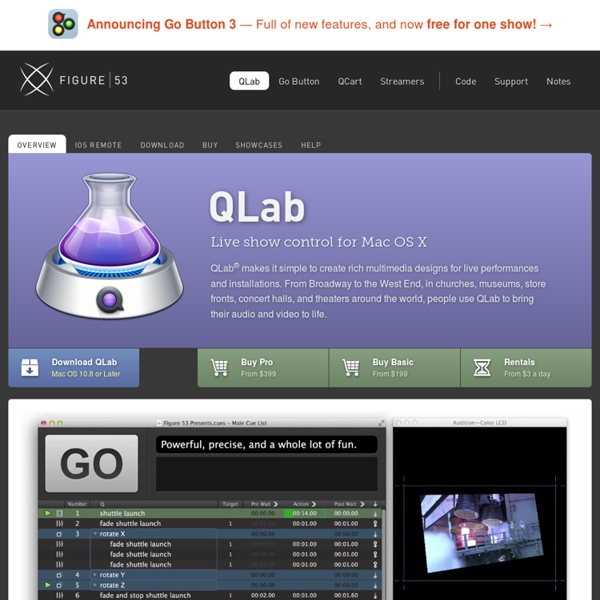



vvvv - a multipurpose toolkit Mattrunks Syphon Syphon is an open source Mac OS X technology that allows applications to share frames - full frame rate video or stills - with one another in realtime. Now you can leverage the expressive power of a plethora of tools to mix, mash, edit, sample, texture-map, synthesize, and present your imagery using the best tool for each part of the job. Syphon gives you flexibility to break out of single-app solutions and mix creative applications to suit your needs. Videos: Syphon Overview | Quartz Composer Integration | FreeFrame GL Integration | Syphon 2K Jitter Demo | Syphon Vimeo Group Features Syphon provides an ecosystem for sharing imagery between applications and new media development environments. Hardware acceleration on the GPU - Servers and Clients share video on the graphics card - where it belongs, allowing for HD or larger video at 60 FPS Alpha-channels - share rendered 3D content and video with masks and keys, allowing compositing to happen easily and naturally. System Requirements News:
3 Easy Ways Anyone Can Learn to Code We live in a digital world, yet far too many people, even millennials, are technologically illiterate. In a world where our smartphones are the first thing many of us touch in the morning and the last thing we touch at night, we need to be honest about the importance of technology, and, consequently, the role basic technical literacy plays in our world today. Jason Nazar encourages millennials to learn code, saying, “If you plan to stay gainfully employed, you better complement that humanities degree with some applicable technical chops.” To those hesitant to make this move, Ian Kinsey, the CEO of Semiformal Studios, which produces the MMORTS RPG game Ensemble, advises that “all it takes is a few days of learning the basics, a few days of figuring out how to get stuff to work, and then a lifetime of just building stuff that you don't know how to build, which is assisted through dedication and feverish googling.” How do you learn this? Marina Olson
Using cues, timelines and VJ software for performances These days as a part of the Obscura crew I am ofting doing visual shows that have more in common with theatre productions than traditional VJing. Often there is some sort of script for a show or a piece of music that is rehearsed. For these types of jobs I have found good use for the application called QLab which is great for triggering a pre planned sequence of events. Actually the whole point of QLab is to line up a sequence of audio, video files or other types of events and being able to trigger them with a simple ‘Go’ button at the exact right time during the show. QLab was originally developed with audio in mind and has later been extended with video features so it does not have many features as VJ applications when it comes to live manipulations of images and video. 1. 2. The advantage of these two methods is that you have some way of combining improvised VJing with a sequence of planned cues.
maltaannon.com | Free Adobe After Effects and Production Studio Video Tutorials Moment Factory | ACCUEIL Home vj labor Elektra, Montreal 2013 (Yatra Arts) from Joel Dittrich on Vimeo. Live audio/visual performance at Elektra festival, Montreal, Canada, 03 may 2013. Curated by Yatra Arts. White Noise/Black Noise is an audio/visual project where I´m experimenting with intermodal aesthetics, creating audio and visuals side by side and performing live with a digital set up, relaying heavily on OSC, MIDI and audio analysis, to control audio and visuals simultaneously. 100% work by me. Resolume Arena, Ableton Live 9 incl. LZX Industries, Doepfer A-100, Jomox Mbase 11, Akai APC40, etc. Many thanks to Alain Thibault, Praveer Baijal, Yatra Arts, Julia Frainier, Amanda'Mour Ihnatowicz, Nathalie Bachand, Motoko Allison Chanic, Greg MTL, Frédéric Auger, a great audience and anyone I forgot to mention!
Mac : 10 applications essentielles pour VJ Vous êtes sur Mac et travaillez dans la vidéo, le Motion Design ou vous êtes tout simplement VJ, voici une liste de quelques applications indispensable à avoir dans votre trousse à outils. Prenez soin de votre machine et donnez-lui les friandises adéquates. Magican - Permet de nettoyer, optimiser, désinstaller, vous donne-les informations système de votre Mac, un outil de maintenance facile à utiliser, contrôle en temps réel, le rendement de votre machine, la température du processeur, de la carte graphique, du ou des disques dures, supprime certains processus pouvant ralentir l'ordinateur. (gratuit) smcFanControl - Cet outil vous donne le contrôle total des ventilateurs, idéal pour les laptops, il indique la température de votre machine. Syphon Recorder - Il permet d'enregistrer à la volée vos set VJing en sortie Syphon sur un disque dur externe par exemple. Syphoner - Streaming de n'importe quelle application via Syphon, idéal pour dessiner en direct et sortir par Millumin ou Modul8.
Dead Drops | Un-cloud your files in cement! 'Dead Drops’ is an anonymous, offline, peer to peer file-sharing network in public space.